| |||||
| |
|||||
| |||||
- Washington Report
- Chemical Landmark Dedication and Workshop
- UC Will Continue to Manage LANL
- UC Endorses Proposition 26
- Lab Scientists Win Technology Transfer Awards
- Search for Quark Gluon Plasma Began at Berkeley
- In Memoriam: Junko Hosoda
- Computer Corner
- Christmas in April Seeks Volunteers for Energy Teams
- New Website Helps Homeowners Reduce Cancer Risk Posed by Radon Gas
- National Women's History Month
- Registration Begins for Summer Exploration Camp
- Bulletin Board
- Calendar of Events
- EH&S Classes - March 2000
- Alvarez Postdoc Fellowship
- Flea Market
- Flea Market Policy
The Hunt for Quark Gluon Plasma Heats Up
CERN Announcement makes headlines, but RHIC is expected to provide more definitive proof of QGP Existence
By Lynn Yarris
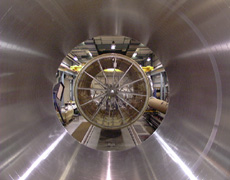 |
Quarks are one of the families of fermions, the basic constituents of matter. Gluons are bosons, carriers of the strong force that binds quarks together into hadrons such as protons or neutrons. In the ordinary matter that makes up us and the world in which we live, quarks are never free of gluons or other quarks. In the experiments at CERN's Super Proton Synchrotron (SPS), however, collisions between high-energy beams of lead nuclei generated temperatures 100,000 times hotter than the interior of the sun. Within the extremely dense fireball at the heart of these collisions, the ties that bind quarks and gluons may have melted, creating a soup-like plasma of free-floating individual particles.
QGP is believed to have been the state of matter under the extreme pressure and temperature conditions that prevailed in the first 10 microseconds after the Big Bang. Although highly transient -- a QGP quickly cools and reverts to the ordinary state of matter -- the QGP in its brief existence set the stage for the combinations of particles that make up our universe today. QGP is also thought to be the state of matter in the dense cores of neutron stars. Creating a QGP in particle accelerators could yield new insights into how our universe was formed and a better understanding of the behavior of atomic nuclei.
"A common assessment of the collected data leads us to conclude that we now have compelling evidence that a new state of matter has been created at energy densities that have never been reached over appreciable volumes in laboratory experiments before, and which exceed by more than a factor of 20 that of normal matter," the CERN announcement read.
In response to this announcement, Xin-Nian Wang, a theorist with NSD says, "The experiments at CERN so far are excellent and have provided us much more information that we did not know before. However, like so many other (relativistic heavy ion) experiments, for each QGP signal there are backgrounds. Sorting out these backgrounds is a challenge. It is like a murder trial without a smoking gun. The key is proof beyond a reasonable doubt. The experiments at SPS have failed to prove beyond a reasonable doubt that the phenomena can only be attributed to QGP and nothing else."
Nuclear theorists are in agreement that if atomic nuclei are squeezed hard enough under conditions of high pressure and temperature, a QGP will form. Over the course of several years' worth of experiments at the SPS, nuclei of lead with their 208 hadrons (82 protons and 126 neutrons) were accelerated into beams with energies in excess of 160 billion electron volts per nucleon and smashed together.
While the data suggests that these lead nuclei were squeezed hard enough to have produced de-confined quark-gluon matter (also referred to as "partonic" matter), many nuclear physicists at Berkeley Lab and elsewhere do not believe there is enough evidence that the QGP was produced.
Everyone, including scientists at CERN, agrees that more definitive proof should be forthcoming from the experiments at RHIC where collisions of gold nuclei will take place at 10 times higher energy densities than the lead nuclei at SPS.
These experiments are expected to yield a true QGP, and hold that state long enough for it to be studied. Berkeley Lab researchers designed and constructed a large volume Time Projection Chamber and a significant portion of the electronics for STAR, one of RHIC's two large-scale detector systems. The higher energy densities in combination with a sophisticated detector array like STAR should make it possible to produce a QGP and perform the types of systematic and meticulous studies needed to understand it.
For example, says Wang, "One way to detect QGP is to scan over a wide range of reactions. Since the matter produced in high-energy heavy-ion collisions is in very small amounts, one does not expect to see very sharp features or discontinuity in the scan. However, if one finds a bump or a step in the scan, it would be an unambiguous signature of QGP."
Another of the promising new experiments scheduled for RHIC is one in which "jets" (energetic beams of quarks) will be observed crossing through the center of the collision fireball where the QGP would be. Analyzing how the jets propagate through the fireball and measuring the amount of "quenching" or energy loss that occurs should reveal whether or not a QGP was created.
Hans Georg Ritter is one of the pioneers in the QGP hunt and now heads NSD's Relativistic Nuclear Collisions program. He says, "The combined results from the experiments at CERN present tantalizing hints of the exciting new physics that await us at RHIC."
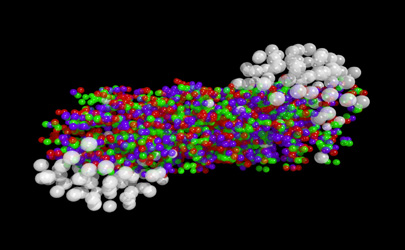 |
Dark Matter "WIMPS" Make News
By Lynn Yarris
New Findings by Lab Collaboration Contradict Other Recent Findings
Some light may soon be shed on dark matter, the invisible stuff of which most of the universe seems to be made. The Cryogenic Dark Matter Search (CDMS), a collaboration of researchers from ten institutions including Berkeley Lab, today announced that they have achieved "the world's best discrimination in the search for dark matter." Their findings appear "incompatible" with the findings reported by another multi-institutional collaboration, the announcement said.
Various astronomical observations combined with more than 70 years of combined astrophysics and particle physics research have shown that perhaps as much as 90 percent of the known universe is made up of matter that is visible to us only by its gravitational effects. Since it cannot be seen by the light it emits, this matter has been dubbed "dark." The nature of dark matter holds implications for the evolution, structure and ultimate fate of the universe, as well as for our current physics models. Consequently, astrophysicists and cosmologists have undertaken an intense search for the source of dark matter. One of the prime potential candidates is a family of weakly interacting massive particles, or "WIMPS."
Last Saturday the New York Times broke the story that the DArk MAtter experiment (DAMA), a collaboration based in Rome and Beijing, was reporting evidence of having found a particular type of WIMP called a "neutralino." This particle was said to be at least 50 times more massive than a proton yet so non-interactive with conventional matter that a billion of them might pass through your body every second without a trace.
The DAMA results were based on three years of data collected on a sodium iodide detector operated deep underground in the Gran Sasso National Laboratory in Italy. In a statistical analysis of tens of thousands of recorded events, seasonal fluctuations were observed that were attributed to the movement of Earth either with or against the flow of a massive cloud of WIMPs permeating our galaxy.
At the Fourth International Symposium on Sources and Detection of Dark Matter in the Universe in Marina del Rey, California, the CDMS collaboration announced their own results, which are based on an entirely new type of detector technology that employs crystals kept at cryogenic temperatures to detect potential dark matter particles. So far, this most discriminating of all dark matter detector systems has found no particles that could be clearly identified as WIMPs. The events they have detected have all been attributed to neutrons.
"The powerful technology we deploy derives its advantage from being able to distinguish background events that result from many of the known particles interacting in the crystals from those that are likely to be dark matter interactions," says Bernard Sadoulet, the spokes-person for CDMS and a staff scientist with Berkeley Lab's Physics Division. "This discrimination allows an unambiguous identification of events in the crystals caused by any new form of matter." Sadoulet is also a professor of physics at UC Berkeley and the head of the Center for Particle Astrophysics where he has been leading the search for WIMP candidates.
The key to the high sensitivity of the CDMS detectors are crystals of germanium or silicon cooled to within 0.1 degrees above absolute zero (the coldest possible temperature). A WIMP such as a neutralino interacting with a nucleus in these crystals will produce both heat and ionization at characteristic ratios which can be used to reject background on an event-by-event basis.
"What is most exciting to me is that we've been able to employ a new type of detector developed explicitly to do this type of measurement, to obtain a result with implications for a fundamental question in cosmology," says UC Berkeley physicist Tony Spadafora, the deputy project manager for CDMS who is also affiliated with the Lab's Physics Division. "These measurements are difficult and take a long time because WIMP signals are thought be very small and infrequent".
Much of the development of the CDMS detectors was done by Sunil Golwala, a UC Berkeley graduate student, working with semiconductor crystal expert Eugene Haller of the Lab's Materials Sciences Division.
The detectors are housed inside a unique cryostat, designed and built at Berkeley Lab by a team led by Ron Ross of Physics Division and Dick Wolgast of the Engineering Division. This cryostat maintains ultra-low temperatures while helping to shield the detectors from cosmic radiation. The CDMS experiment is being carried out inside a cave 10.5 meters below the surface of the Stanford campus. The combination of dirt and cryostat shielding reduces the influence of cosmic and terrestrial radiation by a factor of about 10,000.
The events that do breach the shielding are primarily gamma and beta rays which produce electron recoils within the detectors. WIMPs, including neutralinos, would only interact with atomic nuclei, and the CDMS detectors can tell whether a recoiling particle was an electron or a nucleus by simultaneously measuring the ratio of heat to ionization generated within the germanium or silicon crystals. After eliminating all electron recoils from their data sets, the CDMS researchers observed 13 nuclear recoils. They concluded that all were from neutrons which, like neutralinos, interact only with nuclei.
Says Sadoulet, "No rigorous statement can be made on the compatibility between our experiment and the DAMA experiment because we are using different target materials. However, in the favored theoretical framework we appear to be seriously incompatible. The possibility remains though that the physics for this unknown particle is different from what we expect and that we are both right!"
The CDMS project is funded jointly by the U.S. Department of Energy and by the National Science Foundation in a collaboration coordinated by the Center for Particle Astrophysics. The next phase of the project, CDMS II, has recently been approved by DOE and NSF.
Says Spadafora, "We're starting construction on a version of our apparatus to be run in a former iron mine in northern Minnesota. This deep underground location provides much better shielding from cosmic rays, which will allow us to do an even more sensitive experiment"
In addition to Berkeley Lab, UC Berkeley and Stanford, the CDMS collaboration includes groups from UC Santa Barbara, Fermilab, Case Western Reserve University, Santa Clara University, the National Institute of Standards and Technology, the University of Colorado, and Princeton.
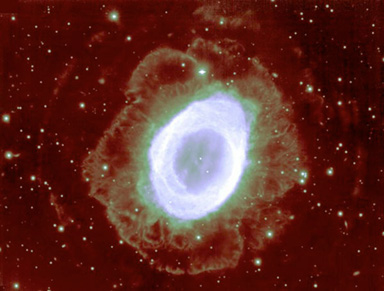 |
Washington Report
House-passed bill slashes funding for DOE computing
A House bill that would slash DOE funding for high-performance computing between FY 2000 and 2004 came under heavy criticism from Energy Secretary Bill Richardson, who said it would "cripple" research in areas ranging from high-energy physics to fusion R&D at NERSC and other facilities.By voice vote the House approved the National Information Technology R&D Act, which authorizes $6.8 billion for high-performance computing work over five years at six agencies, including DOE. The department was scheduled to receive $571 million under an earlier version of the bill, but Rep. Michael Capuano (D-Mass) succeeded in amending it to reduce DOE's share to $303.6 million.
In a letter to House Science Committee Chairman F. James Sensenbrenner Jr., Richardson said Congress must maintain a high level of funding for advanced computing at DOE to achieve long-term scientific research goals. The Capuano amendment, Richardson said, "would deprive a large scientific community of the necessary tools to advance research in many areas, and consequently cripple our ability to address some of the most pressing scientific problems."
In response, Sensenbrenner criticized Richardson and the DOE for not doing "a better job of justifying funding requests." Capuano said Congress should shift computing funding from the DOE to the NSF. Capuano's district includes MIT, which hosts a prominent computing research center.
Bill McCurdy, Berkeley Lab's associate director for Computing Sciences and former head of NERSC, told Inside Energy that NERSC wrote the software that enabled NSF to operate its supercomputers. He also said that cuts in funding for high-performance computing would harm interactions with scientists in other nations who use ESNet, the nationwide computer network that connects DOE labs and universities.
The House measure now goes to the Senate, where a companion bill has yet to be introduced.
DOE creates recycling task force
Secretary Bill Richardson has appointed a task force to review DOE policies governing the release or recycling of contaminated metals and other materials. He also continued a moratorium on the release of volumetrically contaminated metals at department facilities "at least until" the Nuclear Regulatory Commission decides whether to set a standard for the use of such materials."These actions are intended to better ensure the protection of public health and the environment, openness and public trust, and fiscal responsibility," Richardson said in a memo. The task force is co-chaired by Brian Costner and Steve Cary. The Secretary said the panel will review policies "regarding the release of all materials for re-use and recycling."
Lynn Yarris
Chemical Landmark Dedication and Workshop
On Saturday at 3 p.m. the American Chemical Society will dedicate four Berkeley Lab sites (Bldgs. 70, 71, 88 and 5) as National Historic Chemical Landmarks to commemorate the 14 new transuranium elements discovered at the Lab from 1949 to 1999. It was here on the Hill that teams of scientists developed the theories and techniques to synthesize and identify elements with increasingly higher atomic numbers beyond element 96 (curium), culminating in 1999 with the discovery of elements 118, 116 and 114. Their efforts could ultimately extend the Periodic Table to a long-sought region of nuclear stability known as the "Island of Superheavy Elements."
Prior to the site dedication, the ACS will hold a workshop on the Periodic Table, with featured speaker Eric Norman. Photos by Roy Kaltschmidt, collage by Shannon Magee
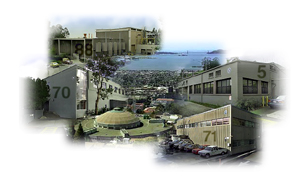 |
UC Will Continue to Manage LANL
The U.S. Department of Energy has announced that the University of California will continue to manage the Los Alamos National Laboratory. DOE said it saw no need to exercise an "off-ramp" option to void its contract with UC, which runs through FY2001, and cited UC's improved environmental record and improvements in safety and health conditions at the lab.
"I am pleased that improvements by UC and Los Alamos management have been made so that the off-ramp provision of the contract did not have to be exercised," Secretary Bill Richardson said in a statement. "We hope UC and Los Alamos continue this trend and that their performance continues to improve."
LANL Director John Browne said a new integrated safety management program has made the lab a safer place and helped improve environmental restoration and waste management. "Our many lab initiatives to strengthen regional and community relations will also continue to grow," Browne said.
The decision not to invoke the off-ramp clause has no bearing on whether DOE will decide to extend UC's contract at LANL when it expires in 2002 or whether to conduct a competition for a new contract, Richardson said.
UC Endorses Proposition 26
Last November the UC Board of Regents adopted a resolution in support of Proposition 26 on the March 7 ballot. If passed, the initiative would allow voter approval of local school bond issues by a simple majority rather than the current two-thirds vote requirement. Local school districts, community college districts and county education offices throughout California would be affected by the change.
"Because it would impact the capability of K-12 schools to fund improved teaching environments and foster higher student achievement, the act may ultimately enhance the preparedness of high school students for enrollment and academic success at UC campuses," said UC President Richard C. Atkinson.
Given the rising K-12 public school enrollment, an additional 63,000 students are likely to attend UC campuses by 2010. New actions will need to be taken, such as construction of new schools, hiring of teachers, and improvements of facilities. The initiative has the support of the CSU Board of Trustees, the California Teachers Association, the California Chamber of Commerce, and the California School Boards Association. It is opposed by Save Our Homes, a group formed by the Howard Jarvis Taxpayers Organization, which argues that the two-thirds standard protects property owners who are responsible for repaying the school bonds.
Lab Scientists Win Technology Transfer Awards
William Chu of Life Sciences and Ashok Gadgil of the Environmental Energy Technologies Division are among the 26 winners of the 2000 FLC Award for Excellence in Technology Transfer, awarded by the Federal Laboratory Consortium for Technology Transfer.
Chu is being honored for his work in applying accelerator-based particle therapy to destroying cancerous tumors. (For more information see the Fall 1997 issue of Research Review.) Gadgil's award recognized his work on the UV Waterworks, a small, inexpensive device that uses ultraviolet light to disinfect water of the viruses and bacteria that cause serious diseases. (See the Dec. 4, 1998 issue of Currents.)
The FLC is a federal agency that helps match the needs of the private sector, state and local governments, and universities with federal laboratory expertise and facilities.
FLC 2000 Awards also went to scientists at five other DOE laboratories. The awards ceremony will be held on May 10 during FLC's national meeting in Charleston, South Carolina.
Berkeley Lab Currents
Published twice a month by the Public Information Department for the employees and retirees of Ernest Orlando Lawrence Berkeley National Laboratory. Ron Kolb, PID department head.
EDITOR: Monica Friedlander, (510) 495-2248, msfriedlander@lbl.gov
STAFF WRITERS: Paul Preuss, 486-6249; Lynn Yarris, 486-5375
CONTRIBUTING WRITERS: Jon Bashor, X5849; Allan Chen, X4210, Jeffery Kahn, X4019
FLEA MARKET / CALENDAR: 486-5771
fleamarket@lbl.gov /
currents_calendar@lbl.gov
Public Information Department, Berkeley Lab, MS 65A
One Cyclotron Road,
Berkeley CA 94720
Tel: 510/486-5771 Fax: 510/486-6641
Berkeley Lab is managed by the University of California for the U.S. Department of Energy.
Search for Quark Gluon Plasma Began at Berkeley
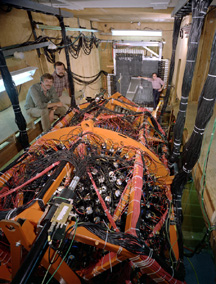 |
The evidence discovered was a phenomenon called "collective flow." In the immediate aftermath of collisions between a beam of niobium and a niobium target it was observed that the protons, neutrons and other subatomic particles released in these collisions hung together for a fraction of a second before flying apart.
"This was our initial look at how dense nuclear matter behaves," says Art Poskanzer, a physicist with Berkeley Lab's Nuclear Science Division (NSD) and one of the leaders of that collective flow experiment.
Another participant in that collective flow experiment was physicist Hans Georg Ritter who at the time was with GSI and how heads NSD's Relativistic Nuclear Collisions program. Says Ritter, "Much of the basic theoretical and experimental framework for our understanding of collisions between heavy nuclei was developed at the Bevalac."
Within a few years, the Berkeley Lab researchers had shifted their focus to the Super Proton Synchroton (SPS) at CERN, where collision energies were 100 times higher than those that could be reached at the Bevalac. In collaboration with scientists from GSI and CERN they initiated a relativistic heavy ion program. Lab researchers helped construct an injector that initially enabled the SPS to accelerate oxygen and sulfur to relativistic energies, and eventually to produce the lead-lead collisions whose results are now being reported.
In a head-on collision between two beams of lead nuclei in the SPS, about 2,500 particles are created, virtually all of them hadrons. Since a change-of-state from ordinary matter to a QGP is almost immediately followed by a change back to ordinary matter, the plasma's existence must be inferred by studying its final products. This requires an elaborate system of detectors.
Berkeley Lab researchers played a major part in the construction of several critical detector systems for the SPS heavy ion program. They also played a major part in the science done on those detectors.
The tradition of Berkeley Lab contributions to detectors aimed at capturing the elusive QGP has continued with the new facility at Brookhaven called the Relativistic Heavy Ion Collider, or RHIC. Berkeley scientists and engineers led the collaboration that designed and constructed STAR -- the Solenoid Tracker At RHIC -- one of the accelerator's two giant detector systems. They will be major participants in the science there as well.
In Memoriam: Junko Hosoda
By Paul Yaswen
Junko Hosoda, a retired Lab biochemist, passed away on Feb. 8 at the age of 67 after a three-year battle with endometrial cancer.
A native of Japan, Hosoda earned her Ph. D. from the University of Tokyo, and was a pioneer among Japanese women pursuing scientific careers. She came to the U.S. on a Fulbright scholarship in 1963 and, after 4 years at MIT, joined the Space Sciences Laboratory. In 1978 she joined Berkeley Lab, where she stayed until her retirement in 1994. Hosuda continued to work here as a guest researcher until her illness made this impossible.
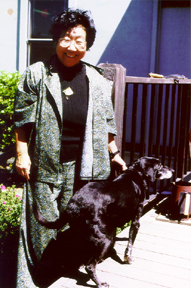 |
Hosoda and her group were among the original Lab denizens of Bldg. 934, an offsite building near Berkeley's Aquatic Park. It was there that she found her beloved Kuro, a stray dog who became her faithful companion for the next 17 years.
Those who worked with Hosoda remember her cheerfulness, her love of research, and her fondness for her adopted country. Her hobbies included gardening, cooking, and most recently silk painting. She also used to decorate Bldg. 934 with fresh flowers and exotic plants.
In her final years Hosoda's serenity and courage in the face of pain and impending death reflected the way in which she lived her life. She credited her illness with giving her an increased ability to appreciate each moment and the importance of human relationships. These insights, together with her scientific legacy and unflagging love of research will continue to be an inspiration to those who knew her.
Hosoda is survived by a sister, a brother, a nephew and a niece. A private service at sea will be scheduled in May by the Neptune Society.
Computer Corner
Training Session on The New IRIS Data Warehouse
The IRIS Data Warehouse, the Lab's centralized web-based source of up-to-date information on finances, purchasing and more, has been streamlined for easier use and increased flexibility. To help users with the transition, the Lab's Information Systems and Services Department (ISS) is sponsoring a brown-bag seminar on IRIS Version 2, to be held on Tuesday, March 7 at noon in the Bldg. 50 auditorium. All interested employees are invited to attend.
IRIS was created several years ago as an electronic alternative to the Lab's central, paper-based reporting system, which churned out stacks of paper reports. With the adoption of PeopleSoft applications for general ledger and human resources data, the Lab also modernized its data reporting system. The result was known as the Integrated Reporting and Information System, or IRIS.
IRIS allows users to check on the financial status of projects and procurements in order to obtain information such as how much has been spent on a project, who is charging a project number, or purchase order status.
Information about training and property records can also be accessed via IRIS. Users can choose a quick status snapshot or request a more formal report.
The new IRIS interface is easier to use than the previous version and makes a wider range of information available to users. Additionally, employees won't need a separate account to access the data. The new version will provide authentication and access using the same underlying employee database as the Lab's IMAP4 e-mail and electronic calendaring systems. Employees who already have IMAP4 passwords can use them for IRIS; those who don't can call the computer support Help Desk at X4357 to obtain a password.
--Jon Bashor
Change Your Passwords
The Computing Infrastructure Support Department recommends that employees change their computer passwords at least once every few months to enhance security, thereby protecting both their own computer's data and that of the Lab's network systems. For assistance with changing or protecting passords, contact the computer support Help Desk at X4357.
Christmas in April Seeks Volunteers for Energy Teams
By Allan Chen
It's almost time for Christmas -- in April, that is. And Lisa Gartland, a former post-doc in the Lab's Environmental Energy Technologies Division is hoping Lab employees will join the effort.
Gartland, now a private consultant on energy efficiency for government agencies, businesses and communities, is organizing "energy teams" for local chapters of Christmas in April, a charitable organization that rehabilitates and repairs homes for low-income, disabled or senior citizens who can't pay for or perform this work on their own.
Every year volunteers come together on one Saturday in April -- the 29th this year -- to paint, repair, make earthquake and other safety improvements, and now, to also enhance the homes' energy efficiency.
"Energy Team 2000 volunteers add energy and water efficiency measures to the mix," Gartland says. "Teams of five to six people will travel from house to house adding compact fluorescent lamps, caulking and weather-stripping, and adding water heater blankets. A few special teams will work on more highly skilled jobs, like adding insulation or replacing light fixtures."
Last year the first energy team visited 30 homes for the Albany/Berkeley/ Emeryville chapter and implemented more than 150 energy and water conservation measures, saving an average of $60 a year for each homeowner. A number of volunteers from Berkeley Lab participated in the effort.
This year the teams will work with six Christmas in April affiliates: the Albany/ Berkeley/Emeryville/Oakland chapter(50 homes), Castro Valley (18 homes), Marin County (12 homes), Mid-Peninsula (60 homes), San Francisco (65 homes), and South Bay (30 homes). They hope to visit more than 200 homes and save residents $12,000 annually in utility bills.
With this goal in mind Gartland started "Rebuild in April," a chapter of DOE's Rebuild America program, which brings energy-efficient and environmentally friendly technologies to communities through local partnerships. This effort allows Garland to tap into DOE resources, including help from Rebuild America's marketing and communications department and contacts with business partners in the energy field. Garland also received a grant from the program's technical support funding, "thanks to the efforts of Berkeley Lab's Rick Diamond and Dale Sartor."
But volunteers continue to be the backbone of Christmas in April. "Anyone is welcome to volunteer for the Energy Teams, regardless of experience," Sartor says. "All it requires is one night of training and your time on April 29th. In return you'll get the satisfaction of helping those in need -- and all the doughnuts you can eat."
To participate contact Lisa Gartland at (510) 595-PNRG, lisa@pstvnrg.com. More information is available on her website at http//www.pstvnrg.com/xina.
New Website Helps Homeowners Reduce Cancer Risk Posed by Radon Gas
By Allan Chen
Radioactive radon gas seeping into houses from the soil below poses a health risk to people living in certain parts of the United States. Now, a new website developed jointly by scientists at Berkeley Lab and Columbia University uses advanced mathematical methods, research on radon gas infiltration and geologic data to help homeowners determine when and how to reduce health risk from radon exposure.
The Radon Project Website ( http: //www.stat.columbia.edu/radon) was developed by Phil Price of Berkeley Lab's Environmental Energy Technologies Division and Andrew Gelman and his colleagues at Columbia University's Department of Statistics.
Radon is a naturally occurring radioactive gas resulting from the radioactive decay of radium. Studies of uranium miners have shown that breathing high concentrations of radon can increase the risk of developing lung cancer. In parts of the United States, enough radon gas seeps out of soil into basements and crawlspaces to pose a health risk to people living in homes built on that soil.
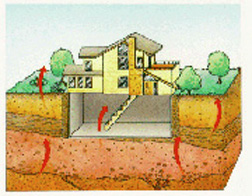 |
Website users pick their home state and county on a U.S. map which shows the estimated median living-area radon concentration by county. They are then asked to provide relevant information, such as the location of the basement, radon measurements made in their area, and the number of smokers and non-smokers living in the house (radon exposure increases the risk of lung cancer more for smokers than non-smokers).
Default values for acceptable risk levels and the estimated costs of reducing exposure to acceptable levels are automatically entered unless the user chooses to adjust these values. The program then calculates the probable level of radon exposure in the user's home and displays an exposure probability curve and a table showing the costs of various measures, such as short- or long-term testing to accurately measure radon levels, or immediate remediation. Recommendations are made based on the exposure level calculated.
Radon levels between 2 and 10 picoCuries per liter (pCi/L) may pose some risk, and levels above 10 pCi/L are considered definitely dangerous. Research estimates indicate that 50,000 to 100,000 U.S. homes have radon concentrations in excess of 20 pCi/L -- a level roughly equivalent to the lifetime exposure of a uranium miner.
Radon levels, however, may vary tremendously even within a single county. To cope with the uncertainty regarding the amounts of radon present at a specific locale, the Radon Project Website software employs a unique method of modeling.
"Hierachical modeling allows the software to take the spatial variability of radon into account when calculating the odds of radon exposure where the home is located," says Price.
Price and Gelman co-developed the computational theory underlying the hierachical modeling. Data and model parameters for the website were provided by Berkeley Lab researchers based on maps of soil radon concentration obtained from the U.S. Geological Survey.
Price wrote the computer code for using the data in the website's software. The Columbia researchers wrote the FORTRAN program to implement the computational theory.
Berkeley Lab researchers have been studying radon infiltration into U.S. homes for more than 15 years and developed the currently preferred remediation method of sub-slab depressurization.
A description of the theory used in the Radon Project Website software was published in the journal Statistical Science, v. 14, no. 3, pp 305-337, "Analysis of Local Decisions Using Hierarchical Modeling, Applied to Home Radon Measurement and Remediation," by Chia-yu Lin, Andrew Gelman, Philip Price and David Krantz.
National Women's History Month
Berkeley Lab is sponsoring activities throughout the month of March in recognition of national Women's History Month. All Lab employees are invited. Students from local area schools will also attend the events, which are organized by the Lab's Work Force Diversity Office.
Speaker Forums
- March 24, noon, Bldg. 50 auditorium
Presenter: Violet E. Smallhorne, M.D.
"What is Plastic Surgery?" will be discussed by Violet E. Smallhorne, a board certified plastic surgeon. She will over-view plastic surgery and also discuss breast cancer awareness. Dr. Smallhorne has a distinguished background in academics, surgical training and cosmetic surgery. She attended medical school at Stanford University.
- March 28, noon, Bldg. 50 auditorium
Presenter: Judith Campisi
Judith Campisi, head of Berkeley Lab's Center for Research and Education in Aging, will talk about "How and Why We Age." Her laboratory studies focus on the cellular and molecular basis of aging and cancer.
Movie Series
- March 16 and March 21,
Noon, Bldg. 50 auditorium
"The Way Home: Stories of Identity, Oppression and Resistance" will be shown. The movie focuses on 64 women representing a cross section of American cultures who share their experiences of oppression through the lens of race.
Websites of Interest
- http://www.utep.edu/library/ref/whmonth.html
- http://www.nwhp.org/reports.html
- http://www.nwhp.org/month.html
- http://www.feminist.org/other/wh_menu.html
- http://lcweb.loc.gov/exhibits/wcf/wcf0001.html
- http://www.rochester.edu/SBA/hisindx.html
- http://www.lbl.gov/Workplace/WFDO/MRG/
Registration Begins for Summer Exploration Camp
Camp positions open
Early registration for the Summer 2000 Science Exploration Camp begins on Wednesday, March 1, for children of Berkeley Lab and UC employees and for last years' participants.SEC runs six one-week sessions from July 24 through Sept. 1 that offer a mix of recreational and science-oriented activities. The program will accommodate approximately 30 children in second through sixth grade.
Camp fees are $180 per week during the early registration period (March 1-March 31), $195 per week during open registration (April 1 - May 15), and $210 per week after May 15. The fees cover the core program (9:00 a.m. to 4:00 p.m.) as well as before- and after-camp care (7:45 to 9:00 and 4:00 to 5:15).
Several SEC positions are currently open:
- camp director: an experienced science teacher capable of developing curriculum for the camp's morning science program. Applicants need to have supervisory experience.
- assistant director : provide continuity between the morning science program and the afternoon recreation program, and lead the recreation program, including outdoor activities, field trips, and quiet time activities.
- camp counselors (three positions open): assist with science activities during the morning and recreational activities in the afternoon. Applicants should be entering twelfth grade or older.
- volunteers: two energetic high school students in grades 8 through 11 are needed to volunteer as counselors-in-training (CITs) for each week of SEC. Under the supervision of the camp director and assistant director, the CIT will assist with science and recreational activities.
For more information about the Science Exploration Camp call X6566, send e-mail to sciencecamp@lbl.gov, or look up the SEC website at http:// eande.lbl. gov/EAP/SEC/secindex.htm.
Bulletin Board
On Their Toes for Black History Month
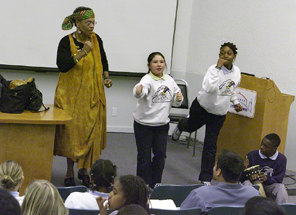 Also part of the program was Hattie Cartwell of the DOE Berkeley site office, who gave a presentation on "Black History and Your Dreams." Photo by Roy Kaltschmidt |
LabVIEW User Group Meeting
National Instruments will be hosting a LabVIEW Users Group meeting at Berkeley Lab on March 14 from 10:30 to 12:00 in Bldg. 50A-5132. A representative will discuss architecture, application development, and deployment pertaining to LabVIEW RT. Specific topics will include real-time data acquisition and control; reducing development time, and lowering costs of real-time systems with flexible, easy-to-use development tools; and off-the-shelf industry standard hardware. Participants will see LabVIEW RT run in real-time on plug-in DAQ boards and on embedded PXI/cPCI controllers.
New Dance Series: Swing, Line Dancing
A new four-week series of dance lessons will start on Monday, March 20, from noon to 1:00 p.m. on the lower level of Bldg. 51. West coast swing and line dancing will be the featured dances. No previous dance experience is required. Free practice sessions are held every Wednesday at noon at the same location. The lessons are taught by professional dance instructor Charlene Van Ness.
The cost is $20 for the four-week session or $6 per lesson on a drop-in basis. Participants are urged to arrive 10 minutes early for the first session to register. For further information contact Joy Kono at JNKono@lbl.gov or Sharon Fujimura at SPFujimura@ lbl.gov.
Courier Services by Facilities and IDS
The Facilities Department is providing the Lab with rush courier service, with pick-up and delivery both on- and off-site. Transportation can deliver up to 2,000 pounds anywhere in the Bay Area or in central or northern California.
Onsite materials will be delivered within one hour. For offsite service, a driver is available during normal business hours for same-day pick up and delivery. To request a pick-up, call Peggy Patterson at X5404.
Courier service (two-hour, four-hour, same day, and rush service) is also available from IDS Courier, which operates 24 hours a day and provides pick-up and delivery anywhere in the Bay Area and in portions of northern and central California. For information call Linda Wright at 548-3263.
Student Fellowship Applications Online
March 8 deadline
Mentors at Berkeley Lab have until Wednesday, March 8 to select students for the DOE-sponsored Energy Research Undergraduate Laboratory Fellowship Program. More than 200 college students with majors in science, computer science and engineering from across the country have selected Berkeley Lab as their first choice for summer research assignments under the program.
Their applications can be viewed online on the Center for Science and Engineering's website at http://csee.lbl.gov/mentors. html. To access the applications users will need to be assigned a user ID and two passwords, which can be obtained by calling Laurel Egenberger at X5190 or the CSEE office at X5511.
The applications currently available are for Round 1, for students who selected Berkeley Lab as their first choice. After the March 8 deadline the application process will move to Round 2, for students who selected Berkeley as their second choice.
Students' stipends, travel and housing are paid by the CSEE. The DOE's Office of Science has encouraged and will support expanding the Laboratory program for this summer.
Ergonomics Class in Downtown Berkeley
The next training class in "Ergonomics for Computer Users" will be held on Friday, March 10 in the Berkeley Tower Building (Bldg. 937, Room 649) in downtown Berkeley from 10:30 a.m. to noon. Employees who wish to take the class should pre-register with Martin Dooly. The class is limited to 20 participants.
The 90-minute training covers various ways to minimize health problems stemming from computer use. These include work station evaluation, changing work habits, and regularly taking breaks and stretching.
For more information, contact Martin Dooly at X4371 or MKDooly@ lbl.gov
EH&S Adds Lessons Learned Website
The EH&S Division has announced the addition to its website of a web page for the Lab's Lessons Learned safety program, developed to help employees avoid past safety mistakes. The program staff identified accidents, mishaps and near misses and suggests actions to prevent their recurrence in an effort to continuously improve safety performance, a central goal of the Laboratory's Integrated Safety Management System.
The Lessons Learned web page can be accessed on the EH&S website at http://www.lbl.gov/ehs/ by clicking on the "Lessons Learned" button in the left margin.
Questions regarding the program may be directed to Larry McLouth at X5286 or ldmclouth@lbl.gov.
Hall of Science Summer Camps
UC's Lawrence Hall of Science is organizing a variety of summer camps which emphasize fun outdoor science exploration through hands-on, inquiry-based activities. Included are residential science camps, Sierra backpacking science camps, and high school research camps. Each camp has a unique theme and is designed for a specific age group:
- Coastline Ecology Exploration, ages 8-10
Camp Redwood Glenn, June 19-23 - Sierran Backpacking, ages 10-14, 11-15, and 12-16
Tahoe National Forrest, July 1-14 and July 23-28
Desolation Wilderness, Aug. 7-12 - Wildlife Biology research, grades 9-12
Sagehen Research Station, July 31-Aug. 5 - Marine Biology Research Camp, grades 9-12
Bodega Marine Lab, Aug. 15-19
Fees include meals, lodging, instruction and transportation to and from the Hall of Science. For more information call 642-2275, send e-mail to lhsinfo@ uclink.berkeley.edu or look up the LHS website at http://www.lhs.berkeley.edu/classes/camps.html . To register call 642-5134.
Blue Trash Bags: Going, Going, Gone
The blue bags lining trash cans all over the Laboratory will be replaced by the end of March with clear trash liners. Specially marked stickers on all containers will identify their purpose. Every container should have a new sticker that reads either "non-recyclable trash" or a specific recycling target.
For more information look up the Lab's recycling guide at http://www-ehs.lbl.gov/wastemin/recycling.html . To obtain sticker call X5129 or X6123.
Calendar of Events
February 2000
GENERAL INTEREST
TUES, FEBRUARY 29
Black History Month PresentationHorace Mitchell, UC Berkeley
12:00 - 1:00, Bldg. 50 auditorium
MoveSMART Training
EH&S 62 class; call X7366
THURS, MARCH 2
Web Ordering Training10:30 a.m. & 1:00 p.m., Bldg. 50 auditorium
Shoemobile
7:30 - 3:30, cafeteria parking lot
Tripmobile
11:30-12:40, cafeteria parking lot
TUES, MARCH 7
IRIS Data Warehouse TrainingNoon, Bldg. 50 auditorium
THURS, MARCH 8
Web Ordering Training10:30 a.m. & 1:00 p.m., Perseverance Hall (cafeteria)
FRI, MARCH 10
Ergonomics for Computer Users10:30 -12:00 p.m., Bldg. 937-649
Items for the calendars may be e-mailed to currents_calendar@ lbl.gov, faxed to X6641, or mailed to Bldg. 65B. The deadline for the March 10 issue is 5 p.m. Monday, March 6.
SEMINARS & LECTURES
FRI, FEBRUARY 25
Center for Beam Physics Seminar Series"Overloading of Truncated Power Series Algebra and Various Differential and Lie Algebraic Operations" will be presented by Etienne Forest of KEK.
10:30 a.m., Bldg. 71 conference room
MON, FEBRUARY 28
Center for Beam Physics Seminar Series"The First 10-36 Seconds" will be presented by Marc Kamionkowski of CalTech.
4:30 p.m., 1 Le Conte Hall, UC Berkeley
TUES, FEBRUARY 29
Life Sciences Division"Obesity in Mice and Men: From the Mouse to Molecules" will be presented by David West of Berkeley Lab's Department of Molecular and Nuclear Medicine
4:00 p.m., Bldg. 66
Refreshments precede the seminar
FRI, MARCH 3
Earth Sciences Division Seminar"The Science and Technology of Ocean Carbon Sequestration" will be poresented by James Bishop of Earth Sciences.
11:00 a.m., Bldg. 90-2063
NCEM Seminar
"Catalyzed Precipitation in Al-Cu" will be presented by
David Mitlin of Materials Sciences.
2:00 -3:00 p.m., Bldg. 72, second floor
conference room
TUES, MARCH 7
Center for Beam Physics Special Seminar"Simulation Study of Electron Cloud Problem and Beam Scrubbing for the LHC" will be presented by Xialong Zhang of IHEP.
2:00 p.m., Bldg. 71B conference room*
*Please note special day, time and venue
EH&S Classes - March 2000
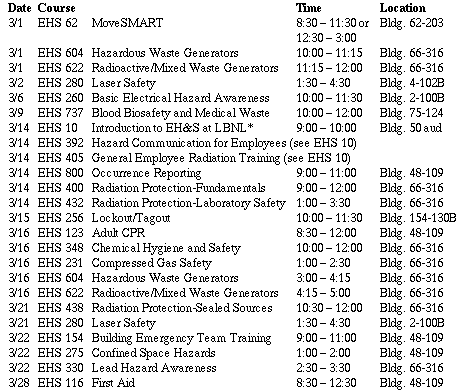
*Includes EHS 392/405, followed by New Employee Orientation; sign-in at 8:45 a.m.
For more information or to enroll, contact Susan Aberg at Saberg@lbl.gov or enroll via the web at http://www-ehs.lbl.gov/ehstraining/registration/. Preregistration is required for all courses except EHS 10 (Introduction to EH&S). Times and locations are subject to change. For a full, updated schedule of EH&S training sessions see http://www-ehs.lbl.gov/schedule/.
Alvarez Postdoc Fellowship
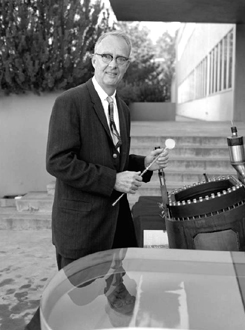 |
Alvarez won the Nobel Prize for physics in 1968.
Fellowship applicants must be recent graduates (within the past four years) with a strong study emphasis in computing or computational science. The fellowship is offered as a one-year term appointment with the possibility of a one-year renewal. The successful applicant will be compensated with a competitive salary and will have access to NERSC's high-performance computing resources.
Applications are due by April 1 for an appointment to coincide with the coming academic year. Applicants should submit a letter of application, a resume and three letters of reference by email to Ewa Elkins, eaelkins@lbl.gov.
Flea Market
Auto / Supplies
`96 CHEVY 2500 PU, ext cab,V8, 88K, tow pkg, runs exc, ac, am/ fm/cass, pwr locks, tint wndw, cruise, alloy whls, bedliner/custom bump, $16,000, Sonya, Clint, 724-5210`94 FORD Mustang, silver, V6, 3.8 L, 72K, fully loaded, runs exc, all maint current, $7,900/bo, Lisa, (925) 906-9786, X5314
`94 FORD Taurus, $5,800, 56K, 4 dr sedan, alarm, ac, abs, cruise, Peter, X5973, Patricia, (925) 687-1827
`93 FORD Escort LX wagon, white, 5 sp, am/fm/cass, ac, 59K, new brakes, runs great, $3,400, Simon, 848-7968
`92 OLDSMOBILE Bravada SUV, fully loaded, all wheel drive, 145K, clean, $6,800/bo, Barbara, X7840, (925) 939-7754 (aft 4:30)
`91 CHEVY Corsica, lt, at, ac, pd, new brakes, new alt, 170K, runs well, $2,200/bo, 704-8239
`91 FORD Taurus GL Stn Wgn, blue, 85K, 3.8 L V6, ac, am/fm/ cass, cc/pd/pw 3rd seat, $4,200, Scott, X4103
`91 HONDA Accord LX, 4 dr, blk, at, ac, fully loaded, stereo, car phone, exc cond, 145K, hwy mileage, $6,950/bo, Mohammed, pager (510) 389-7694,
`90 VW Jetta GLI, 16V, 5 spd, 4 dr, white, Recaro seats, BBS rims, am/fm/cass, 102K, new trans, orig owner, all records, $3,000/bo, Joe, X7284
`89 CHEVROLET Celebrity, blue, 87K, gd cond, garaged, well maint, ac, ps, cd/radio, $2,300/bo, Klaus, X2232, Darius, (415) 699-1816
`87 PLYMOUTH Grand Voyager LE mini-van, 7 psgr, 119K, V6, auto, ac, pwr steer/wndws/locks/ dr/seat, tilt wheel, cruise, roof rack, am/fm/cass, orig owner, no accidents, maint records, gd cond, $3,350, Ron, 486-4410
`84 SUBARU DL 4 dr wagon, 145K, man trans, radio/tape deck, runs well, $1,000/bo, Lynn, X6519, 524-2966
`79 Mercedes 450 SEL, clean, well maint, garaged, 140K, 190 HP, V8 gas engine, reduced to $3,200, Dick, (925) 284-5236
`79 PONTIAC Grand Prix, 157K, 8 cyl, 301 engine, runs well, maintained, recently passed smog check, interior fair, $850/bo, Wim, X7788
`69 VW BEETLE, Porsche(?) engine, at, exc cond, body pan rusted, 93K, $1,500/bo, X4703, 482-1777
Housing Available
LOVELY HILL HOME, short term, 4/8-6/1 for 1-2 persons, $400/wk, will reduce to $300/ week if you care for gentle dog, Seymour, Barbara, 841-8308NO BERKELEY HILLS, furn rm, bath, sep ent, near Lab, transp, non-smoking physics household w/ dog, $450 per month incl util, stable tenant, request some caregiving/help driving for pay, refs, Senta, Owen, 524-4654
PINOLE, 1 bdrm/1 bth for rent in house w/ working female, cats/ small dog, non-smoker/ drinker, full kitchen/laundry, $600/month incl util, cable, possible carpool to Lab, Sue, X6661, 758-4164
SO BERKELEY studio apt in quiet brown shingle 4-plex, walk to campus, utils incl, $530/mo, Guy, X4703, Kathy, 482-1777
Housing Wanted
1 BEDROOM studio apt, single prof, end of March, long-term, Inna, X2419, (925) 933-1747FRENCH GUEST SCIENTIST & spouse, 2/15, 1-2 yrs, pref furn, 1-2 bdrms, Laurent, dmlorenzetti@lbl.gov
NEW EMPLOYEE seeks 2-3 bdrm house w/ fenced yd for self/husband/daughter (12), dog, mid-June, 1 yr min, pref furn, X6857, eves 848-7800, rm 408
Miscellaneous
BABY CRIB, Childcraft, light oak, gd cond, meets crib safety standards, $75, Tracy, X5215, 727-0135DESK, blk melamine computer desk, 4' wide, no drawers, retractable keybd/mouse tray, like new, $20/bo, Armin, X7184
ELECTRONIC PIANO, Yamaha CLP-123, spinet style w/ MIDI, connections, scarcely played, incl bench, $1,300, Loretta, Bill, 420-6979
FUTON SOFA, blk frame, $75; desk seat, $15, 526-5495 (eves)
GLASS dinner table w/ 4 blue velour chairs, $40; Aprica double stroller, $125; hamster habitrail cage $10; Peter, X5973, Patricia, (925) 687-1827
HP 855C Deskjet printer, exc cond, new color/blk ink cartridges incl, $120/bo, 595-1755
OAK BOOKCASES (3), 2 to 5 shelves, 76" by 32", one has drop desk & 3 drawers, one w/ cupboard/shelf, $120 for all or $50 each, Betsy, 843-1643
ORGAN, Deluxe Spinet, Kimball Model M405, exc cond, special effects, controls, lighted keynotes, chord guides, matching upholstered bench, some music, photo avail, $300, Vicky, X2952
OUTDOORS DOG PEN, 6'x6'x4 cyclone fence w/ gate, you haul, $75/bo, single bed frame mattress, bo; computer desk, $100, Dan, X7275, 245-9038
QUEEN SIZE BED, exc cond, like new, has built-in pad on both sides of mattress, $250; Graco blue/green plaid stroller, exc cond, pd $150, sell for $75, Baby Toons comforter, bumper pad, lamp, mobile, gd cond, $100, Lisa, (925) 906-9786, X5314
REFRIGERATOR, small, outside 33"x24"x20", gd cond, $40, Bill, X8614
SCANNER, UMAX 1200S, SCSI interface cable (w/ SCSI card for PC, not needed for Mac), 8.5"x 14" scan area, 600x1200 opt res, software, exc cond, $100/bo; Alps Glidepoint Trackpad for ADB equip Mac, gd cond; floppy disk holders (25 disks: $5, 50 disks w/ lock: $10); Minolta XG-7 SLR camera, 20 yrs old, doesn't work, w/ lens, $20/bo; Vivitar 3700 AutoThyristor flash, $10/ bo; Eddie Bauer dress watch, quartz, needs new band/battery, $15; Britta 2+ liter water pitch w/ 6 extra filters, $20/bo, Jon, X5974
SOFABED, blk, gd cond, $200/bo, vinyl, Willow, X7498, 558-9558
SUPERPHON Revelation Plus, $250; Marantz CD17 mkII $750; Pioneer DV525, $175; Weslo Cardioglide, $60, Dave, X4506
SYMPHONY NO. 1 CDs by Flavio Robles, Jr, orig cd, composed on computer using sampled orch instrum/choir, 56 min, $12, Flavio, X5997, 841-9196
WASHER/dryer, white, new, used 1 mo, $550/bo, Sue, X4628, 486-4628
Vacations
LAKE TAHOE, spacious chalet, Tyrol area, close to Heavenly, peek of lake from front porch, fully furn, sleeps 8+, sunny deck, pool, spa in Club House, close to casinos, shopping, Pat, Maria, 724-9450TAHOE KEYS at So Lake Tahoe, 3 bdrm house, 2-1/2 bths, fenced yd, quiet, sunny loc, skiing nearby, great views of water/ mntns, $150/night, 2 night min, Bob, (925) 376-2211
Wanted
GUITAR CASE for acoustic guitar, used is fine, Jacob, X4606VAN POOL, SF, Haight/Noe Valley/Castro, to UCB/Lab, 8 am/ 5 pm, need extra rider, David, X6013
Free
ROLLAWAY BED, twin, thick mattress w/ metal folding frame, very comfortable, Rosemary, X2426, (925) 229-4275
Flea Market Policy
Ads are accepted only from LBNL employees, retirees, and onsite DOE personnel. Only items of your own personal property may be offered for sale.Submissions must include name, affiliation, extension, and home phone number.
Ads must be submitted in writing only -- via e-mail (fleamarket@lbl.gov), fax (X6641), or delivered/ mailed to Bldg. 65B. Ads run one week only unless resubmitted in writing, and are repeated only as space permits.
The deadline for the March 10 issue is Thursday, March. 2.
